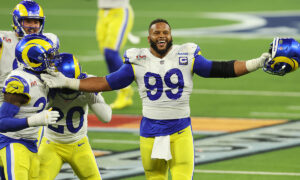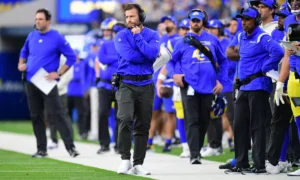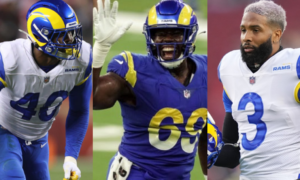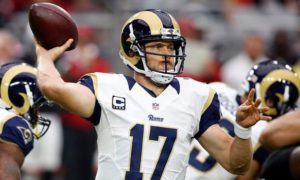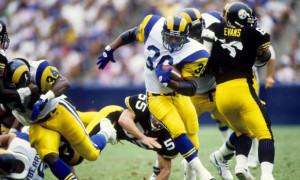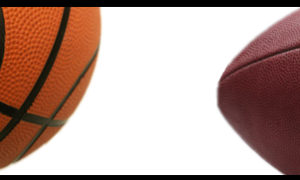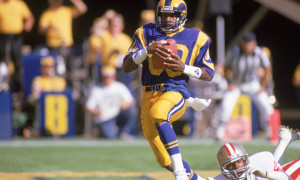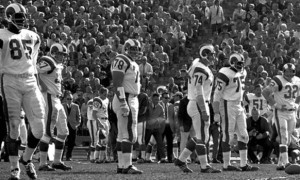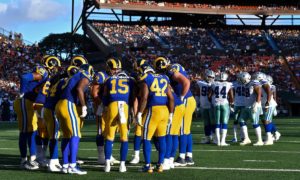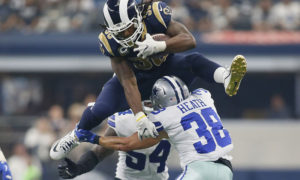1937 – The Beginning of the Rams Organization in the NFL
The Rams organization was officially established in Feb. 13, 1937. This happened just four years after the first ever NFL championship game was played and brought the league to an even 10 teams: Washington Redskins, New York Giants, Pittsburgh Pirates, Brooklyn Dodgers, Philadelphia Eagles, Chicago Bears, Detroit Lions, Green Bay Packers, Chicago Cardinals and the Cleveland Rams.
That’s right, the Rams organization originated in Cleveland, Ohio and also sported the team colors of red and black. The league granted Homer Marshman and Associates the rights to the franchise for a total of $10,000. The Cleveland Rams played most of their home games at two predominately baseball stadiums: Municipal Stadium and League Park.
The Rams struggled during their first season in the league. In fact, the Cleveland Rams were last in virtually every statistical category while finishing with a league-worst 1-10 record. Their sole win was a 21-3 victory over the hapless Philadelphia Eagles on September 21. The Rams then finished their season on a nine-game losing streak.
1938 – Season of Improvement
The Rams struggles from the previous season carried over to 1938. The team lost the first three games of the season, which means they lost 11 straight games including last season and they lost 12 of their total 13 games since becoming a franchise.
With a winning percentage of .077, the Rams parted ways with head coach Hugo Bezdek and hired assistant coach Art Lewis. The next three games were consecutive victories for the Rams picking up wins against the Detroit Lions and twice against the Chicago Bears.
The season was still mediocre the Rams finished with a record of 4-7, but progress was made, and the Rams did improve their record substantially compared to last season.
Much of the credit for the team’s modest success belongs to the emergence of blocking back Ed Goddard and fullback Johnny Drake. Both players were selected to the Pro Bowl.
The Rams introduced their new and familiar uniform color scheme blue and yellow-gold and played all of their home games at Shaw Stadium. Shaw High School used that stadium for their football team in Cleveland, Ohio. The school still uses it to this day.
1939- A Sign of Hope
For the first time since entering the league, the Cleveland Rams did not have a losing season. The team evened up its record at 5-5-1, and the difference was a new man in charge. The Rams interim head coach Art Lewis returned to his duties as assistant coach, and replaced him with Earl “Dutch” Clark.
Clark had quite the resume as a coach. He played two years for the Portsmouth Spartans and four years with the Detroit Lions. Clark’s official position was quarterback, but the main reason he was labeled that was because he called the plays.
In reality, Clark played multiple positions. He was the epitome of a true “triple-threat back,” meaning that he had a decent pass completion percentage, rushed the ball consistently and drop-kicked the ball accurately too.
These characteristics landed him not only in the NFL Hall of Fame, but College Football Hall of Fame as well. Although he had not been inducted yet, the Rams figured he would make a decent coach due to his successful past. He did increase the winning percentage slightly for the 1939 season.
The Rams also fielded their first All-Pro athlete in quarterback/tailback Parker Hall, who was second in the league in passing yards with 1,227 yards and fifth in rushing. Hall also earned a trip to the Pro Bowl along with teammates fullback Johnny Drake and left end Jim Benton, who led the team in receiving touchdowns with seven.
1940- Newer Look, Older Results
Things seemed to be looking up for the Cleveland Rams as they entered their fourth season as a franchise. Head Coach Earl “Dutch” Clark completed a semi-successful season in 1939, and rookie Parker Hall turned out to be one of the most promising young prospects in the league.
With that in mind, the organization decided to give the team a sharper color scheme in blue and yellow-gold. However, despite the emegence of Hall and the new team colors, the Rams took a step backward and finished with a 4-6-1 record.
One of the bright points of the season was fullback Johnny Drake being named to the All-Pro team after leading the Rams with nine rushing touchdowns. Rookie blocking back Vic Spadaccini was also selected to the Pro Bowl.
1941- The New Reign
The Rams entered the 1941 season looking for any glimmer of hope after the previous year’s disappointing results. Hall of Fame owner Daniel F. Reeves and Fred Levy Jr. took over the franchise prior to the season, and one of their first major decisions was to hire general manager Billy Evans. Unfortunately, the changes in the front office failed to produce an immediate result.
The 1941 season was the second-worst season in franchise history only doing slightly better than the very first season in 1937. The team finished in last place in the West Division with a 2-9 record. Two games into the season the Rams appeared to be on a roll after earning victories over the Pittsburgh Steelers and the Chicago Cardinals. However, the team fell apart soon afterwards.
Signs of the Rams minimal success can be found in the amount players representing the team in the Pro Bowl. Kicker Chet Adams was the only player from the Rams named to the Pro Bowl.
1942- War Impacts the NFL
The effects of World War II took its toll throughout the country and even affected the NFL. Many players and owners answered the call to duty and enlisted in the military. It was considered a great honor to enlist in the military during America’s time of need, and these young men preferred to enlist rather than continuing their promising pro football careers.
It wasn’t not just players that enlisted. Owners Dan Reeves and Fred Levy Jr. both enlisted in the U.S. Armed Forces during the 1942 season. Reeves achieved the rank of Lieutenant while Levy earned the rank of Major.
Other notable actions from the 1942 season included general manager Billy Evans’ resignation and Charles “Chile” Walsh’s addition to the staff as the team’s new assistant coach.
On the field, the Rams’ did improve their record to 5-6. Halfback Dante Magani, center Dutch Elston, halfback Bosh Pritchard, kicker Chet Adams and guard Riley Matheson represented the team in the Pro Bowl. Matheson also earned 1st-team All-Pro honors.
1943- The Lost Season
As World War II was continuing its course, the Rams received permission from the NFL to suspend its operations for one season due to the shortages from the war. Most of the players that didn’t enlist joined other NFL teams on loan.
The suspended season didn’t prevent the team from completing various transactions. In fact, an important transaction occurred when Dan Reeves bought out Fred Levy Jr.’s share of the team. Reeves then became the sole owner of the Rams.
Earl “Dutch” Clark resigned as the team’s head coach after compiling a career record of 16-26-2. The Rams promoted Chile Walsh to the position after being the team’s assistant coach for one season.
Offensive Guard Riley Matheson earned All-Pro honors after being “loaned” to the Detroit Lions. Despite having one of the Rams best players, the Lions still finished with a 3-6-1 record.
1944- Adding the Missing Pieces
The Rams returned after missing the previous season and while several transactions occurred during that time, there were still some positions that needed to be filled both on and off the field. Chile Walsh was promoted from head coach to general manager replacing Billy Evans, who resigned in 1942. Walsh quickly appointed Aldo “Buff” Donelli as the team’s new head coach. Walsh also had to add many free agents in order fill in areas for the players that decided to join the military and fight in World War II.
Walsh’s efforts weren’t immediately effective, but there were signs that the Rams were finally making their move up the league standings after finishing with a 4-6 record. Riley Matheson once again proved himself as the team’s best player, earning 1st-team All-Pro honors for his efforts in the 1944 season.
1945- A Season to Remember: From Bottom to the Top
This season is one fans of this generation will always remember. This is when the Rams truly began to build a legacy for being an innovative franchise. The Rams started this trend when they became the first team in NFL history to ever use a full-time college football scout in Eddie Kotal.
Aldo Donelli decided to enlist in the war, which caused Walsh to replace him with his brother Adam Walsh as the team’s head coach. Walsh was not exactly a novice when it came to football. In fact, he was considered to be one the best collegiate centers of all time and was inducted to the College Football Hall of Fame.
Walsh proved to be a great fit with the Rams as the team had the best season in Cleveland. A lot of the credit to this amazing season clearly belonged to the young prospect out of UCLA, Bob Waterfield. Waterfield was known as a T-formation quarterback, which meant he was often used with as many as three running backs in an attempt to confuse defenders.
Walsh went on to win Coach of the Year and five players earned All-Pro honors: Bob Waterfield, Riley Matheson, Jim Benton, Eberle Schultz and Jim Gillette. Waterfield was also the first player in NFL history to earn the Most Valuable Player award unanimously.
Waterfield made all the difference and was partially responsible for reviving Benton’s career. Benton broke the NFL record for receiving yards in a game when he caught 10 passes for 303 yards in a 28-21 win against the Detroit Lions. This record stood until 1989 when another Rams player, Flipper Anderson, broke it.
The Rams finished the season with a record of 9-1 gaining their only loss against the Philadelphia Eagles. They earned their first division title and winning season in franchise history. They completed their final year in Cleveland by winning their first NFL championship in a 15-14 victory over the Washington Redskins.
The following season the Rams left Cleveland for Los Angeles.
You can follow Johnny Gomez on Twitter @Johnny5not6. Be sure to follow Rams Talk on Twitter @TalkRams.
Sources: Profootballreference.com, Profootballhof.com, Stlouisrams.com


